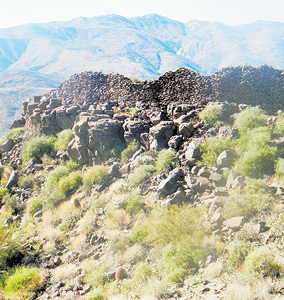
Black Mesa Ruins. (Gary Every photo)
By Gary Every
Special to the Crier
Thousands of people drive past Black Mesa every day, zipping along Interstate 17 without any idea that atop the steep black cliffs is one of the bigger sets of Native American ruins in the entire state. Some of the stone walls stand fifteen feet high and there are more than forty rooms comprising Black Mesa. One reason the ruins remain so unknown and undisturbed is that you cannot spot the stone walls from the highway. One must negotiate the steep, slippery slope, navigating between agave and prickly pear, before you gain your first glimpse of the ruins. Then you still have more climbing to attain the mesa. From the top you can see everything – the views are tremendous with vistas stretching in every direction.
Black Mesa ruins are located just off Interstate 17 on the east side of the road, barely north of Black Canyon City between mile markers 245 and 246. The little known ruins are only ¾ of a mile from the road but be forewarned it is a very steep and slightly treacherous ¾ of a mile – nearly straight up. Because of the steepness and because the mesa is comprised of black stone, this is not a good hike for the hot summer months. Because of the steepness, slippery slope, and plants with thorns, this is not a hike to be taken lightly.
But the rewards for those willing to climb Black Mesa are tremendous. The ruins are in amazing shape for being over 800 years old.
On one particular winter day I hike with my Lakota friend Clint. We explore the former village of Black Mesa, pondering what life must have been like for the inhabitants eight hundred years ago. One thing we can say for certain is that the view from their home was tremendous in all directions. Inspired, Clint and I circumnavigate the mesa. The top of the mesa is maybe twice the size of a football field and littered with pottery shards. I believe they were farming the top of the mesa, planting corn, beans, and squash. Traditionally, it was the job of the young maidens to journey in the early hours of the morning and return with water, large pots carried atop their heads. What an undertaking that must have been every daybreak, the long and rigorous journey to the Agua Fria River far below and then back up, carrying heavy water vessels.
After we finish circumnavigating the mesa, enjoying the stupendous views, we pause to look at the petroglyphs on the east side of the ruins. The rock art is scattered with only a dozen or so boulders adorned with images, many of them geometric, some stick figure men in various poses, and a few footprints etched into the rock. We stare with curiosity at this ancient penmanship, unable to decipher the meaning while the stone walls of the village tower above us.
I realize I have a stone in my pocket, a treasure from a recent hike, a fossilized snail shell about the size of a fingernail, embedded in white Kaibab limestone, dating back to the days of the dinosaurs when all of this was the bottom of an ancient ocean. I show Clint my fossil and he begins to tell me a tale of his youth. Usually his stories involve the Detroit Tigers, favorite baseball team for us both, but today his story involves visiting his grandfather’s ranch in the heart of the Lakota Reservation and attending the Sun Dance Ceremony. Usually we talk about books, the language of nerds, but when Clint speaks about his native heritage his speech becomes clipped and vowels rounded with long pauses between sentences as his reservation accent grows.
As a boy it was Clint’s job to go to the river. He would gather rocks and small boulders for use in the sweat lodge ceremonies. Once when he was gathering limestone boulders for the Sun Dance Ceremony he pulled a large rock from the stream, discovering himself staring face to face with a bison.
Startled, Clint dropped the rock with a loud splash but thank god it didn’t break. Clint picked the stone up again and stared eye to eye with the bison face embedded in the rock. The bison never acknowledged his existence but Clint stared with fascination at the mostly complete bison visage with both horns clipped short and all but a trace of jaw visible in the stone. Later, paleontologists would speculate that the bison had died 30 to 40,000 years ago, probably by trying to cross the river while it was frozen and falling through the ice. The bison body on the river bottom was quickly covered by sediment and the process of fossilization began.
After he took the stone back to his grandfather’s ranch, the elders placed it upon the altar for the Sun Dance Ceremonies. The drums beat, the dancers danced, and the singers sang, while the fossilized bison never changed expression. As the ceremonies continued the drums beat and beat until they began to mimic the sound of a million buffalo hooves stampeding across the prairie, the earth thundering with their percussion, echoes of long ago days when vast herds spread across the grasslands.
I slip my snail fossil back into my pocket.
This style of hilltop fortress marks a specific period in archeological history when the Hohokam and Salado began to build large stone hilltop fortresses; such as Black Mesa, Forteleza, and Tuzigoot. Archeologists are still split whether this trend in hilltop architecture was a sign of warfare or was done for religious and aesthetic reasons. What we do know is that those willing to undertake the rigorous hike to the top of Black Mesa are rewarded with the remains of a village pueblo some of whose fifty or so stone walls still stand fifteen feet tall and some incredible views in all four directions.

